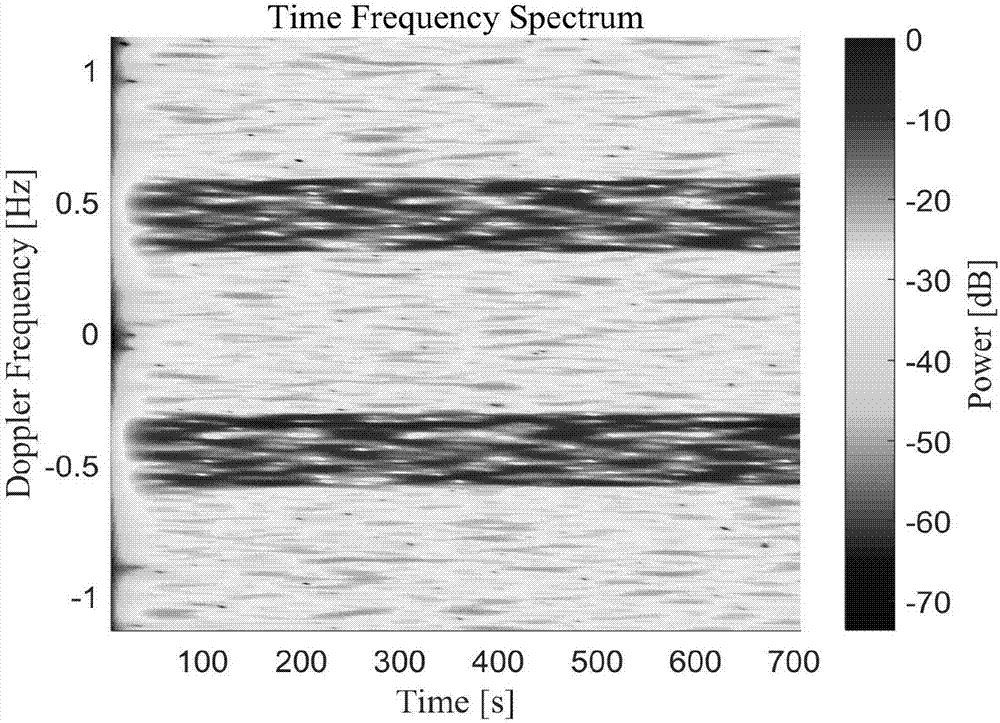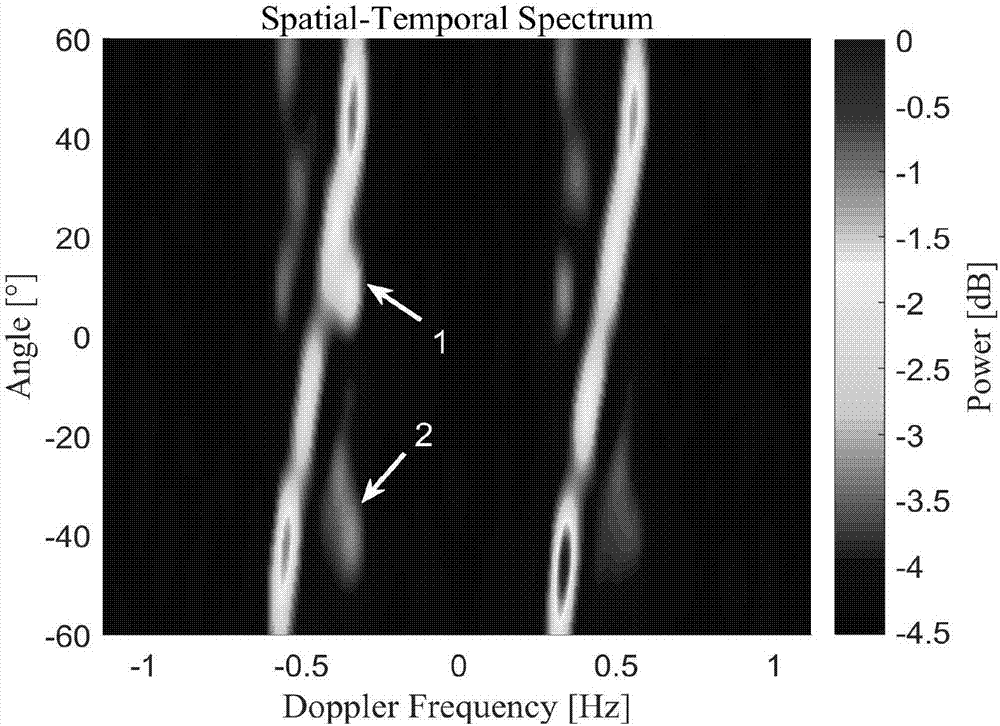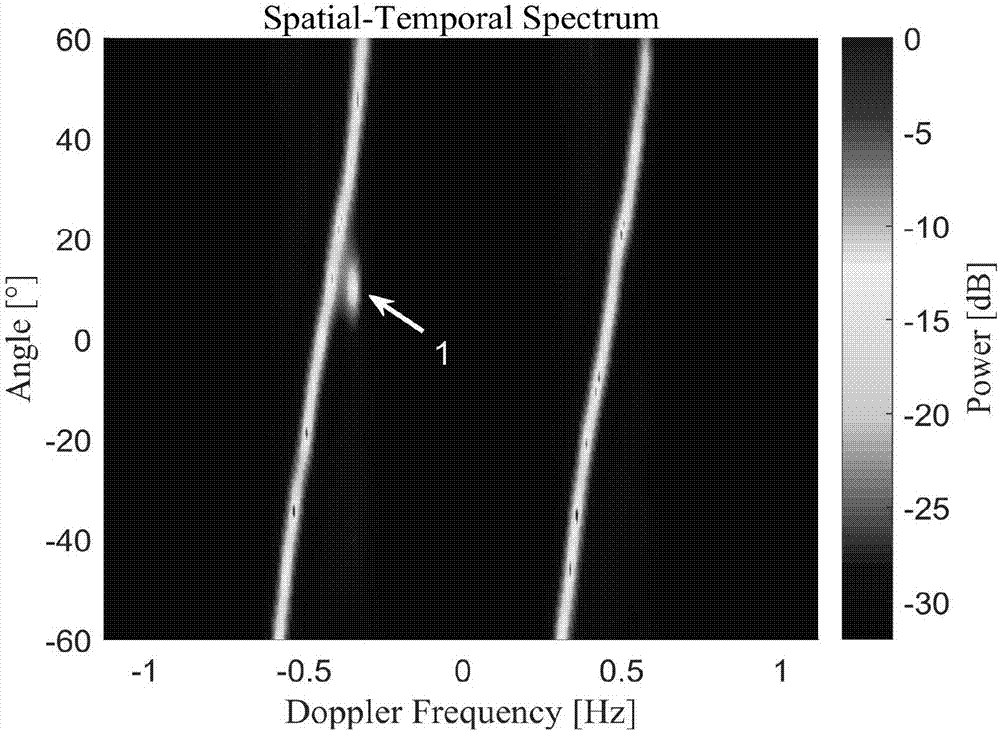High-frequency radar target detection method based on sparse recovery space-time spectrum estimation
A radar target, sparse recovery technology, applied in the field of radar, to achieve the effect of great military value and civil aviation management value, great application potential, and great application value
- Summary
- Abstract
- Description
- Claims
- Application Information
AI Technical Summary
Problems solved by technology
Method used
Image
Examples
Embodiment 1
[0048] Taking target detection in the first-order sea clutter area of high-frequency radar as an example, the advantages of sparsely restored space-time spectrum estimation for target detection are explained. The simulated target signal is as follows: figure 1 As shown, it is difficult to detect the target signal in the time Doppler spectrum. When using the classic two-dimensional MUSIC algorithm to estimate the two-dimensional space-time spectrum, the result is as follows figure 2 As shown, due to the insufficient number of snapshots and insufficient covariance matrix statistics, it is difficult for the target signal to form an effective aggregation area. To solve this problem, follow-up processing is as follows:
[0049] Step 1: Divide the airspace dimension into a grid by 1°, the scanning range is -60°~60°, and divide the Doppler dimension by 0.01Hz, and the scanning range is the entire Doppler sampling frequency band. Step 1 constitutes a dictionary of space-time guida...
Embodiment 2
[0057] Taking target detection in the first-order sea clutter area of high-frequency radar as an example, the advantages of space-time spectrum estimation based on sparse recovery for target detection are explained. The measured echo data are as follows: Figure 5 As shown, the dotted line is the AIS data of the target. When the space-time cascading scheme is used, it is difficult to detect the target only from the time Doppler spectrum because the target is covered by sea clutter. When two-dimensional estimation is performed according to the classic MUSIC algorithm, the result is as follows Image 6 As shown, it is also difficult for the target signal to form an effective accumulation area. The target is detected by sparsely restored space-time spectrum estimation, and the process is as follows:
[0058] Step 1, select 256 points sampled in the time domain of the distance unit to be detected, and each 32 points constitute a space-time snapshot. Since the number of array ch...
Embodiment 3
[0066] The process of the present invention is further described in detail with multi-target detection in dense scenes. For the time Doppler spectrum of measured data, see Figure 9 , when the two-dimensional space-time spectrum is estimated directly based on the classic MUSIC algorithm for multi-target echo data, the result is as follows Figure 10 As shown, only two targets can be detected, and the signal-to-noise ratio is low, only about 5dB. The spectral peak is not sharp enough, and it is difficult to effectively detect and distinguish multiple targets. In order to optimize the detection performance, the processing is as follows:
[0067] Step 1, select 256 points sampled in the time domain of the distance unit to be detected, and each 32 points constitute a space-time snapshot. Since the number of array channels is 8, each space-time snapshot is 256-dimensional, forming a total of 256*8 The space-time snapshot matrix of ;
[0068] Step 2: Divide the airspace dimension ...
PUM
 Login to View More
Login to View More Abstract
Description
Claims
Application Information
 Login to View More
Login to View More - R&D
- Intellectual Property
- Life Sciences
- Materials
- Tech Scout
- Unparalleled Data Quality
- Higher Quality Content
- 60% Fewer Hallucinations
Browse by: Latest US Patents, China's latest patents, Technical Efficacy Thesaurus, Application Domain, Technology Topic, Popular Technical Reports.
© 2025 PatSnap. All rights reserved.Legal|Privacy policy|Modern Slavery Act Transparency Statement|Sitemap|About US| Contact US: help@patsnap.com



